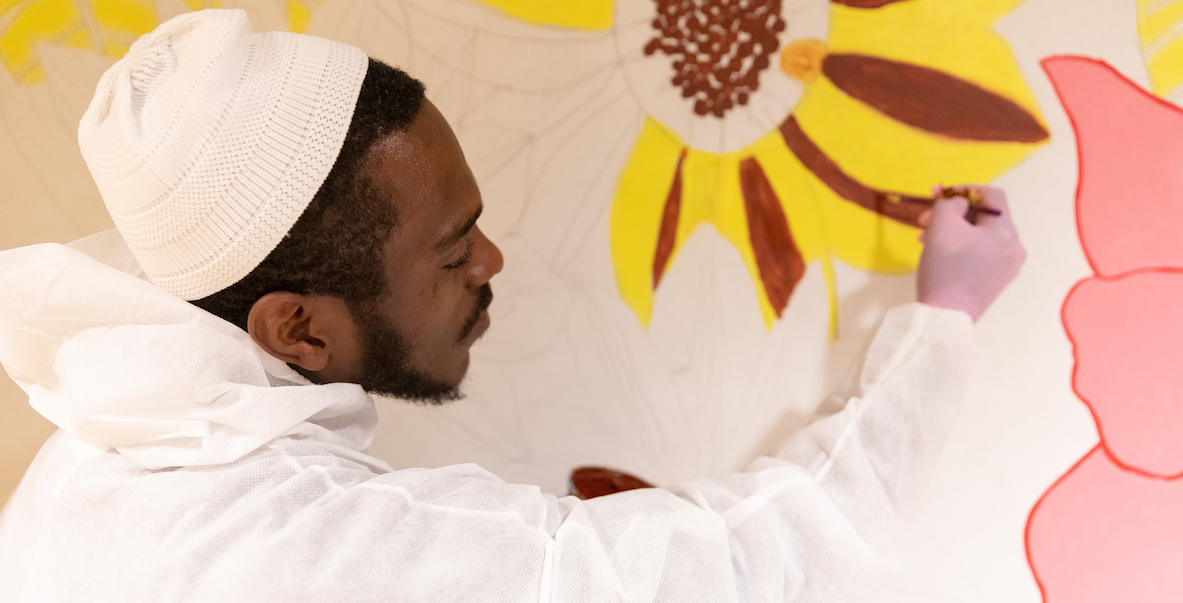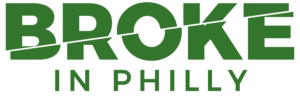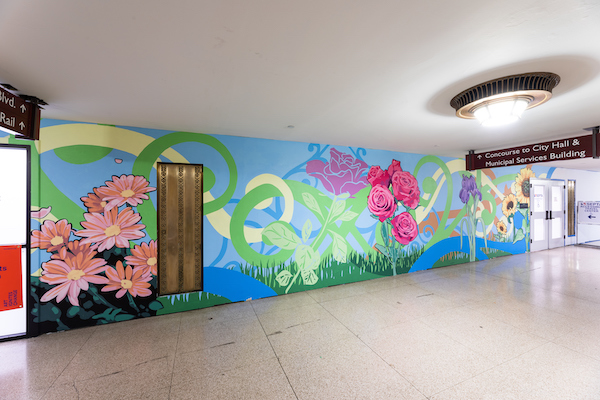Putting Art To Work
Do Something
Help Homeless Philadelphians
Want to practise your role to assist those who are economically insecure? Come across our Practise Something Guide for helping hungry and homeless Philadelphians.




Connect WITH OUR SOCIAL Activity TEAM
Learn More
About Broke in Philly




The Citizen is one of 20 news organizations producing Broke in Philly, a collaborative reporting project on solutions to poverty and the city'south push towards economical justice. Follow the project @brokeinphilly.

See some more Citizen Broke stories here:

Putting Fine art To Work
Mural Arts paid 430 homeless Philadelphians $22,000 to paint a mural in Suburban Station and access social services. Their efforts, and a urban center pilot, aim to help even more people in need
-
Do Something
Help Homeless Philadelphians
-
Learn More than
About Bankrupt in Philly
Putting Art To Work
Mural Arts paid 430 homeless Philadelphians $22,000 to paint a landscape in Suburban Station and admission social services. Their efforts, and a city pilot, aim to help even more than people in need
Aug. 05, 2019
In the southeast concourse at SEPTA's Suburban Station, a poorly-lit and one time stained white wall at present welcomes commuters with a 57-foot hand painted mural boasting big vivid flowers and radiant summer colors. But the real significance of the landscape, unveiled this week, is less the fine art—and more the artists.
 The mural is the showtime installation in a 28 week pilot plan by Landscape Arts Philadelphia called Colour Me Back, a same 24-hour interval work and pay plan that pays economically insecure people in Philadelphia $50 cash for three hours of public fine art making. The program, which launched on Apr 23 and is funded by grants from The Barra Foundation and The Sheller Family Foundation, holds a lottery every morning from Mon to Th at Beloved Park, where 10 people are selected to work that day. An average of 54 people show up to Love Park every morning to participate in the lottery; 29 percentage of them alive in a shelter and 22 percent live in a public area.
The mural is the showtime installation in a 28 week pilot plan by Landscape Arts Philadelphia called Colour Me Back, a same 24-hour interval work and pay plan that pays economically insecure people in Philadelphia $50 cash for three hours of public fine art making. The program, which launched on Apr 23 and is funded by grants from The Barra Foundation and The Sheller Family Foundation, holds a lottery every morning from Mon to Th at Beloved Park, where 10 people are selected to work that day. An average of 54 people show up to Love Park every morning to participate in the lottery; 29 percentage of them alive in a shelter and 22 percent live in a public area.

In the first thirteen weeks of the program, over 430 participants received payments totaling more $21,950. Only the bear upon of Color Me Back extends across cash payment. Participants also piece of work with outreach specialists who connect them with social and behavioral health services and potential opportunities for long term employment.
Michael Belo struggled for years to find a place to alive before eventually moving to an apartment he could barely afford. Half-dozen months later on, he was amongst the first to show up for the job lottery at Love Park. He came back iii days earlier his name was chosen to work on the mural in Suburban Station. Once he started, Mural Arts staff quickly recognized his artistic talent, and he was hired as an banana artist.
"This program will change your life, if you let it," Belo said at a ribbon-cutting ceremony in front end of the mural that he helped create. "I would 1 solar day like for every person that is currently homeless to one solar day be standing where I am."
Color Me Back—which Landscape Arts Executive Director Jane Golden says is the showtime ![]() same 24-hour interval work and pay art program in the United States—is modeled after similar programs in Albuquerque (which The Citizen wrote about in 2016) Phoenix, and Denver; and other organizations, similar Metropolis Bright , which pays homeless people each Saturday morning time to make clean upwardly trash, take been rolled out in Philadelphia. Thank you to Color Me Dorsum, the City is also almost to launch a $300,000 pilot programme with funding from various city departments, to pay homeless and others who are economically insecure to clean empty lots and graffiti throughout the urban center.
same 24-hour interval work and pay art program in the United States—is modeled after similar programs in Albuquerque (which The Citizen wrote about in 2016) Phoenix, and Denver; and other organizations, similar Metropolis Bright , which pays homeless people each Saturday morning time to make clean upwardly trash, take been rolled out in Philadelphia. Thank you to Color Me Dorsum, the City is also almost to launch a $300,000 pilot programme with funding from various city departments, to pay homeless and others who are economically insecure to clean empty lots and graffiti throughout the urban center.
Gilded says that many of the people that Landscape Arts works with have limitations that brand a full fourth dimension chore incommunicable for many reasons. Just many of them want to work. "People desire to feel useful," says Golden. "And why not let them transform this city into something more beautiful?"
As Color Me Back continues, Golden says that they will continue to piece of work with SEPTA to create more murals in concourses throughout the metropolis. She says they already looking at several other locations.
"Our goal," says Golden, "is to be correct at that nexus of art and social change…How practice we move the needle? How tin can art be useful? How do we mine the incredible creativity and genius and talent that resides in then many people across our city only that has only been historically unrecognized? Permit'south shift that paradigm and put fine art to work on behalf of our city'southward nigh-vulnerable citizens."
Header photo: Steve Weinick 



Source: https://thephiladelphiacitizen.org/putting_art_to_work/
0 Response to "Putting Art To Work"
Post a Comment